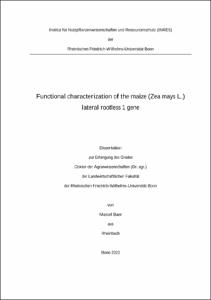Functional characterization of the maize (Zea mays L.) lateral rootless 1 gene

Functional characterization of the maize (Zea mays L.) lateral rootless 1 gene

| dc.contributor.advisor | Hochholdinger, Frank | |
| dc.contributor.author | Baer, Marcel | |
| dc.date.accessioned | 2022-12-14T11:07:03Z | |
| dc.date.available | 2022-12-14T11:07:03Z | |
| dc.date.issued | 14.12.2022 | |
| dc.identifier.uri | https://hdl.handle.net/20.500.11811/10522 | |
| dc.description.abstract | All root types form lateral roots. They are critical for efficient water and nutrient uptake by increasing the absorbing surface of the root system. In the maize differentiation zone, pericycle and endodermis cells adjacent to the phloem poles contribute to the formation of lateral roots in a multi-step process.
The lateral rootless mutant lrt1 was initially identified in an EMS mutation screening. It lacks lateral roots on the embryonic primary and seminal roots during early development. During later development these root types are able to build some rudimentary lateral roots. Shoot borne roots are not affected by this defect and are able to build normal lateral roots. Up to maturity, the lrt1 mutant shows a delayed development of the shoot and root system with a clear reduction in shoot and root dry mass in comparison to wild type plants. The lrt1 gene was mapped to the long arm of chromosome 10 by a combination of mapping and BSA-seq experiments. In the present study, the lrt1 gene was validated by the generation of two novel mutant alleles by genome editing via CRISPR/Cas9. Phylogenetic analyses in selected plant species showed that the lrt1 gene encodes a DCAF protein homolog, which is a subunit of the CUL4-based E3 ubiquitin ligase complex (CRL4). DCAF proteins are substrate receptors, which enable their ubiquitylation and thus their subsequent degradation in the 26S proteasome. The maize genome contains 55 genes with one to three DWD-motifs, which are characteristic for DCAF proteins. LRT1 has been duplicated during evolution and maps together with its paralog LRT1-LIKE to a monocot-specific clade of DCAF proteins. Gene expression analysis showed, that lrt1 is preferentially expressed in the root meristematic zone and that the paralogous genes lrt1 and lrt1-like likely act in independent molecular pathways. A FRET co-localization experiment demonstrated the nuclear localization of LRT1, as expected for a DCAF protein. In summary, the cloned lrt1 gene encodes a protein homologous to the DCAF subunit of the CRL4 complex and was validated to be an important regulator of lateral root development in maize. | en |
| dc.language.iso | eng | |
| dc.rights | In Copyright | |
| dc.rights.uri | http://rightsstatements.org/vocab/InC/1.0/ | |
| dc.subject.ddc | 630 Landwirtschaft, Veterinärmedizin | |
| dc.title | Functional characterization of the maize (Zea mays L.) lateral rootless 1 gene | |
| dc.type | Dissertation oder Habilitation | |
| dc.publisher.name | Universitäts- und Landesbibliothek Bonn | |
| dc.publisher.location | Bonn | |
| dc.rights.accessRights | openAccess | |
| dc.identifier.urn | https://nbn-resolving.org/urn:nbn:de:hbz:5-69149 | |
| dc.relation.doi | https://doi.org/10.1111/nph.18599 | |
| ulbbn.pubtype | Erstveröffentlichung | |
| ulbbnediss.affiliation.name | Rheinische Friedrich-Wilhelms-Universität Bonn | |
| ulbbnediss.affiliation.location | Bonn | |
| ulbbnediss.thesis.level | Dissertation | |
| ulbbnediss.dissID | 6914 | |
| ulbbnediss.date.accepted | 07.12.2022 | |
| ulbbnediss.institute | Landwirtschaftliche Fakultät : Institut für Nutzpflanzenwissenschaften und Ressourcenschutz (INRES) | |
| ulbbnediss.fakultaet | Landwirtschaftliche Fakultät | |
| dc.contributor.coReferee | Schaaf, Gabriel | |
| ulbbnediss.contributor.orcid | https://orcid.org/0000-0001-7708-7202 |
Dateien zu dieser Ressource
Das Dokument erscheint in:
-
E-Dissertationen (1116)




